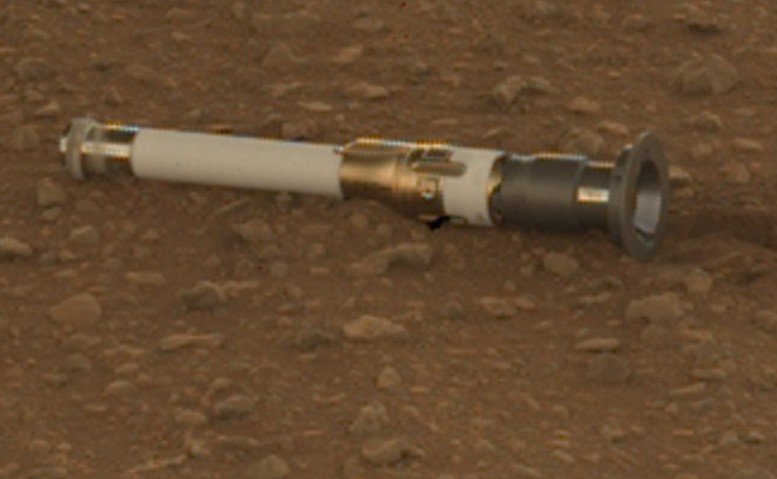NASA’s Perseverance rover has uncovered what could be the clearest sign of ancient life on Mars. Scientists announced on September 10, 2025, that a rock sample from Jezero Crater shows unusual spots and chemicals that point to possible microbial activity billions of years ago.
The Big Find in Jezero Crater
Perseverance drilled into a rock called Cheyava Falls in July 2024 while exploring an ancient river valley in Jezero Crater. This spot on Mars once held a large lake, making it a prime area to hunt for signs of past life.
The rover collected the sample from a formation known as Bright Angel. Early scans showed odd leopard-like spots on the red rock. These features caught the eye of experts right away because they look like patterns seen on Earth where microbes once lived.
This discovery builds on years of Mars missions. Perseverance landed in 2021 to search for biosignatures, which are clues left by living things. The crater’s history of water flows adds weight to the idea that life could have thrived there long ago.

What Sets Cheyava Falls Apart
The rock stands out with its unique markings and makeup. Scientists describe small black specks like poppy seeds and larger white spots ringed in black. These patterns suggest chemical reactions that might come from tiny organisms.
Inside the sample, named Sapphire Canyon, experts found organic compounds. These are carbon-based molecules often linked to life. On Earth, similar spots form when microbes break down rocks and leave behind minerals.
Perseverance used tools like its SHERLOC scanner to spot these details. The rover also detected minerals that form in water, hinting at a wet past. While not proof of life, these traits are hard to explain with just rocks and weather alone.
Experts compared this to Earth rocks from ancient lakes. The match raises exciting questions about Mars history.
Here are key features of the Cheyava Falls rock:
- Leopard spots: White areas with black rims, possibly from microbial action.
- Organic matter: Carbon compounds that could signal biological processes.
- Mineral veins: Signs of water flowing through cracks billions of years ago.
- Reddish color: Due to iron oxides, similar to rusty soils on Earth.
Year of Study Yields Key Insights
After collecting the sample, teams spent a year testing it with rover instruments and Earth-based models. A study published in Nature on September 10, 2025, details the findings. Researchers say the spots might come from microbes using energy from chemicals in the rock.
This fits with Mars’ timeline. The planet was warmer and wetter about 3.5 billion years ago, much like early Earth. If life started there, it could have left traces in places like Jezero.
The analysis ruled out some non-life causes, like volcanic activity. But scientists stress that more tests are needed. They plan to bring samples back to Earth for deeper checks.
Recent events tie in here. In 2025, NASA launched new missions to study Mars’ atmosphere, adding context to these finds. The agency also runs habitat tests on Earth to prepare for human trips, which could help verify such discoveries.
| Timeline of Perseverance Key Events | Date | Details |
|---|---|---|
| Landing on Mars | February 18, 2021 | Rover touches down in Jezero Crater to search for life signs. |
| First rock samples | September 2021 | Collects initial cores from crater floor. |
| Cheyava Falls discovery | July 2024 | Drills into spotted rock in ancient river area. |
| Analysis announcement | September 10, 2025 | NASA reveals potential biosignatures after peer review. |
| Planned sample return | 2030s | Mission to bring rocks to Earth for lab tests. |
Why This Matters for Mars Life Hunt
Finding possible biosignatures shakes up our view of the solar system. If confirmed, it means life might have existed beyond Earth, changing how we see the universe.
This boosts calls for more Mars exploration. Experts say it could guide searches on other worlds, like Jupiter’s moon Europa. It also sparks debate on how life starts and survives in harsh spots.
On the flip side, some warn against jumping to conclusions. Past Mars finds, like methane gas hints, turned out to be from rocks, not life. This keeps the science grounded.
The emotional pull is strong. People worldwide follow these updates, dreaming of alien life. It inspires students and fuels space programs.
Road Ahead for NASA and Beyond
NASA aims to return the samples through a joint mission with Europe in the coming years. Advanced labs on Earth could confirm if the spots are truly from microbes.
Meanwhile, Perseverance keeps rolling, collecting more rocks. The rover has gathered 27 samples so far, each a piece of Mars’ puzzle.
This find ties into broader space goals. With private companies like SpaceX planning Mars trips, evidence of life could speed up human visits.
Share your thoughts on this Mars breakthrough in the comments below. Did it change how you see the red planet? Spread the word by sharing this article with friends interested in space news.
